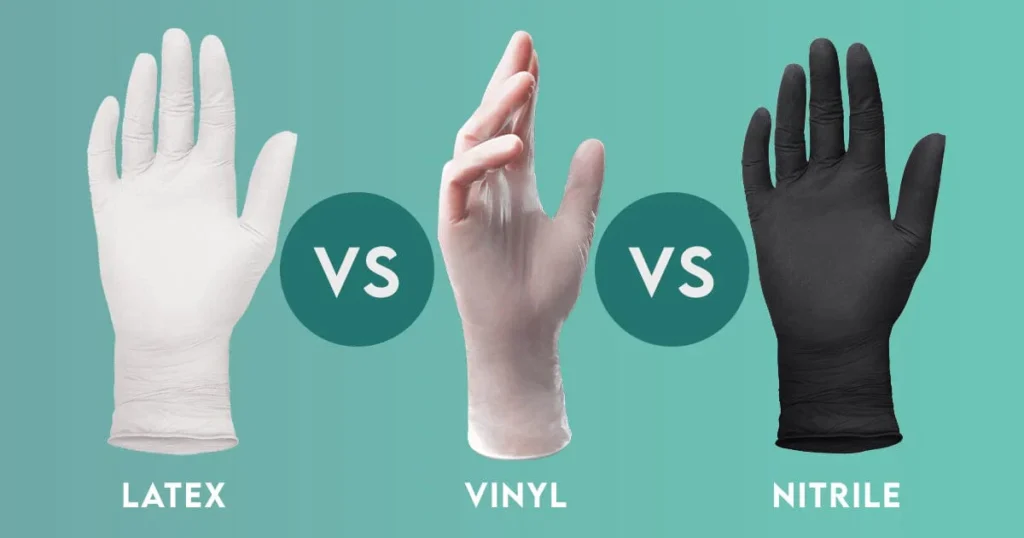When it comes to food handling, hygiene and safety are of the utmost importance. Whether in a restaurant, food processing plant, or home kitchen, gloves play a crucial role in preventing contamination and ensuring food safety. Among the most commonly used disposable gloves are nitrile, latex, and vinyl gloves. While each type has its advantages and disadvantages, not all gloves are equally suitable for food handling. In this article, we’ll explore the differences between nitrile, latex, and vinyl gloves and determine which one is the best for food-related tasks.

1. Understanding the Basics
Before comparing the gloves, it’s important to understand what each type is made of and what properties they offer.
Nitrile Gloves
- Made from a synthetic rubber called acrylonitrile-butadiene.
- Highly durable, puncture-resistant, and chemical-resistant.
- Available in both powdered and powder-free varieties.
- Often used in medical, industrial, and food service environments.
Latex Gloves
- Derived from natural rubber.
- Known for their elasticity, comfort, and sensitivity.
- May cause allergic reactions in some individuals due to the presence of natural proteins.
- Commonly used in healthcare and food service industries.
Vinyl Gloves
- Made from polyvinyl chloride (PVC).
- Generally less expensive and less durable than nitrile or latex.
- Looser fit and less tactile sensitivity.
- Suitable for short-duration, low-risk tasks.
2. Key Factors in Choosing Gloves for Food Handling
When selecting gloves for food handling, several key factors should be considered:
- Food Safety Standards: Gloves must be FDA-approved and free from harmful chemicals.
- Allergen Concerns: Especially important in public food service settings.
- Durability and Resistance: Protection against punctures, tears, and exposure to oils or chemicals.
- Comfort and Fit: Ensures dexterity and reduces the risk of glove failure.
- Cost and Availability: Budget considerations for large-scale operations.
3. Comparing the Three Glove Types for Food Handling
A. Nitrile Gloves – The All-Around Performer
Pros:
- Excellent resistance to punctures, tears, and many chemicals.
- No risk of latex allergy.
- Available in various thicknesses for different tasks.
- Compliant with FDA and USDA standards for food contact.
- Powder-free versions reduce contamination risk.
Cons:
- Slightly more expensive than vinyl.
- May feel stiffer to some users compared to latex.
Verdict for Food Handling:
Nitrile gloves are widely considered the best option for food handling due to their durability, chemical resistance, and safety profile. They are especially useful in environments where exposure to oils, greases, or cleaning agents is common, such as commercial kitchens and food processing plants.
B. Latex Gloves – Comfort with Caution
Pros:
- Excellent flexibility and tactile sensitivity.
- Comfortable fit for extended wear.
- Good barrier protection against bacteria and viruses.
- Biodegradable.
Cons:
- Risk of allergic reactions, which can be severe in some cases.
- Less resistant to oils and certain chemicals.
- Not suitable for environments where latex allergies are a concern.
Verdict for Food Handling:
Latex gloves can be used for food handling, especially in short-term or low-risk scenarios. However, due to allergy concerns and lower chemical resistance, they are becoming less popular in professional food service settings.
C. Vinyl Gloves – Cost-Effective for Light Use
Pros:
- Affordable and widely available.
- Easy to put on and remove.
- Acceptable for low-risk, short-duration tasks.
Cons:
- Low puncture and tear resistance.
- Poor fit and limited tactile sensitivity.
- Not suitable for handling fatty foods or chemicals.
- May leach plasticizers, raising food safety concerns.
Verdict for Food Handling:
Vinyl gloves are generally not recommended for heavy-duty or prolonged food handling tasks. They may be acceptable for brief tasks like packaging or serving, but their lack of durability and potential safety issues make them a less-than-ideal choice for most food service environments.
4. Which Glove Should You Choose for Food Handling?
The best glove for food handling depends on the specific needs of the situation:
- For Commercial Kitchens, Food Processing, and High-Risk Environments: Nitrile gloves are the top choice. They offer the best combination of protection, durability, and safety compliance.
- For Smaller Establishments or Allergy-Free Environments: Latex gloves may still be used, but only if no latex allergies are present among staff or customers.
- For Low-Risk, Short-Duration Tasks: Vinyl gloves may be acceptable, but they should be used cautiously and only when appropriate.
5. Best Practices for Using Gloves in Food Handling
Regardless of the glove type, proper use is essential:
- Wash hands before putting on gloves to prevent contamination.
- Change gloves between tasks, especially when switching between handling raw and cooked foods.
- Avoid touching your face or other surfaces while wearing gloves.
- Dispose of gloves properly after use.
- Ensure gloves are food-grade and meet FDA standards.
Conclusion
In the battle of nitrile vs latex vs vinyl gloves, nitrile emerges as the clear winner for most food handling applications. Its superior durability, chemical resistance, and hypoallergenic properties make it the safest and most reliable option for both professional and home kitchens. While latex and vinyl gloves have their place, especially in terms of cost and comfort, they come with significant limitations that make them less ideal for food safety.
Choosing the right glove is not just about cost or comfort—it’s about protecting both food and people. In food handling, nitrile gloves offer the best balance of safety, performance, and compliance, making them the preferred choice across the food industry.


